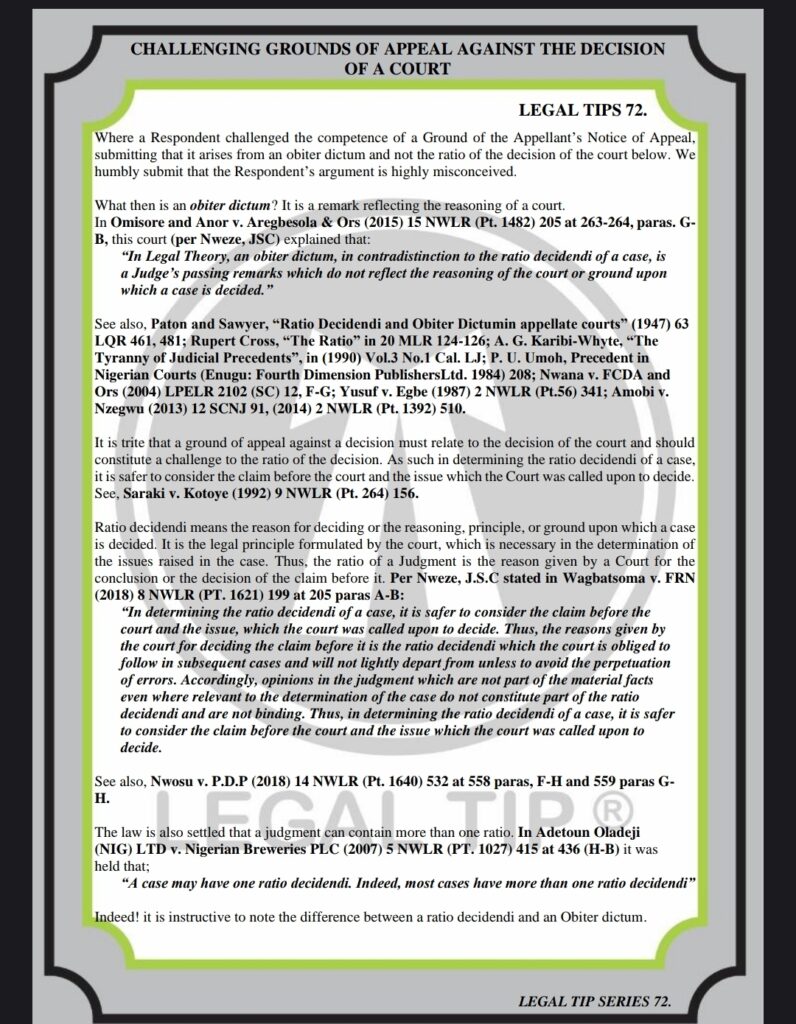Where a Respondent challenges the competence of a ground of the appellant’s Notice of Appeal, submitting that it arises from an obiter dictum and not the ratio of the decision of the lower court. We humbly submit that the respondent’s argument is highly misconceived.
What then is an obiter dictum? It is a remark reflecting the reasoning of a court.
In Omisore and Anor v. Aregbesola & Ors (2015) 15 NWLR (Pt. 1482) 205 at 263-264, paras. G-B, this court (per Nweze, JSC) explained that:
“In Legal Theory, an obiter dictum, in contradistinction to the ratio decidendi of a case, is a Judge’s passing remarks which do not reflect the reasoning of the court or ground upon which a case is decided.”
See also, Paton and Sawyer, “Ratio Decidendi and Obiter Dictumin Appellate Courts” (1947) 63 LQR 461, 481; Rupert Cross, “The Ratio” in 20 MLR 124-126; A. G. Karibi-Whyte, “The Tyranny of Judicial Precedents”, in (1990) Vol.3 No.1 Cal. LJ; P. U. Umoh, Precedent in Nigerian Courts (Enugu: Fourth Dimension PublishersLtd. 1984) 208; Nwana v. FCDA and Ors (2004) LPELR 2102 (SC) 12, F-G; Yusuf v. Egbe (1987) 2 NWLR (Pt.56) 341; Amobi v. Nzegwu (2013) 12 SCNJ 91, (2014) 2 NWLR (Pt. 1392) 510.
It is trite that a ground of appeal against a decision must relate to the decision of the court and should constitute a challenge to the ratio of the decision. As such in determining the ratio decidendi of a case, it is safer to consider the claim before the court and the issue which the Court was called upon to decide. See, Saraki v. Kotoye (1992) 9 NWLR (Pt. 264) 156.
Ratio decidendi means the reason for deciding or the reasoning, principle, or ground upon which a case is decided. It is the legal principle formulated by the court, which is necessary in the determination of the issues raised in the case. Thus, the ratio of a Judgment is the reason given by a Court for the conclusion or the decision of the claim before it. Per Nweze, J.S.C stated in Wagbatsoma v. FRN (2018) 8 NWLR (PT. 1621) 199 at 205 paras A-B:
“In determining the ratio decidendi of a case, it is safer to consider the claim before the court and the issue, which the court was called upon to decide. Thus, the reasons given by the court for deciding the claim before it is the ratio decidendi which the court is obliged to follow in subsequent cases and will not lightly depart from unless to avoid the perpetuation of errors. Accordingly, opinions in the judgment which are not part of the material facts even where relevant to the determination of the case do not constitute part of the ratio decidendi and are not binding. Thus, in determining the ratio decidendi of a case, it is safer to consider the claim before the court and the issue which the court was called upon to decide.
See also, Nwosu v. P.D.P (2018) 14 NWLR (Pt. 1640) 532 at 558 paras, F-H and 559 paras G-H.

The law is also settled that a judgment can contain more than one ratio. In Adetoun Oladeji (NIG) LTD v. Nigerian Breweries PLC (2007) 5 NWLR (PT. 1027) 415 at 436 (H-B) it was held that;
“A case may have one ratio decidendi. Indeed, most cases have more than one ratio decidendi”
Indeed! it is instructive to note the difference between a ratio decidendi and an Obiter dictum.
LEGAL TIPS is anchored by Ms CIA Ofoegbunam, an Abuja-based lawyer who is passionate about legal practice. LEGAL TIPS offers quick hints on substantive law, as well as rules of practice and procedure, and serves as a handy reference guide to lawyers, especially in court. Published on a weekly basis, the LEGAL TIPS Series is CIA’s modest contribution to legal development in Nigeria.



